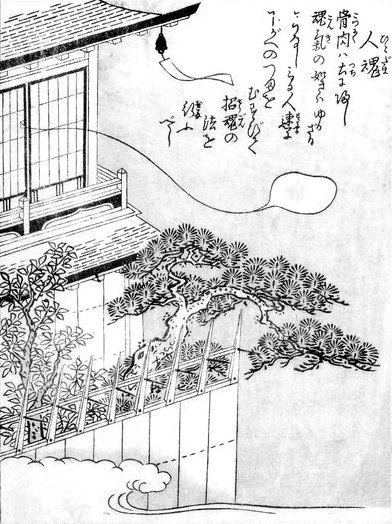 | ||
In Japanese folklore, Hitodama (Japanese 人魂; meaning "human soul") are balls of fire that mainly float in the middle of night. They are said to be "souls of the dead that have separated from their bodies," which is where their name comes from.
Contents
Summary
Hitodama are mentioned in literature from ancient times. In the Man'yōshū, there is the following poem:
When you are alone and meet the complete blueness of a hitodama, you would naturally think of it as the sorrow on a rainy night
They are frequently confused with onibi and kitsunebi, but since hitodama are considered to be the "appearance of souls that have left the body and fly through the air," they are strictly speaking a different general idea.
Concerning their shape and nature, there are common features throughout Japan, but some differences could also be seen depending on the area. They fly crawling along at an elevation that is not very high. They have a color that is blue, orange, or red, and also have a tail, but it can either be short or long. There are also a few that have been seen during daytime.
In the Okinawa Prefecture, hitodama are called "tamagai", and in Nakijin, they are said to appear before a child is born and in some areas are also said to be mysterious flames that drive off humans to death.
In Kawakami, Inba District, Chiba Prefecture, (now Yachimata), hitodama are called "tamase," and are said to come out of the body 2 or 3 days after a human dies, and go toward temples or people they have a deep relation with and are said to make a great sound in storm shutters and gardens, but it is said that this sound can only be heard by those who have a deep relation with the spirit. Also, for those who have not seen a tamase by the time they are 28 years of age, a tamase would come towards them saying "let's meet, let's meet (aimashou, aimashou)" so even those who have not seen one when they are 28 years old will pretend to have seen one.
Theories
According to one theory, "since funerals before the war were burials, so it would be common for the phosphorus that come from the body to react to the rain water on rainy nights and produce light, and the meager knowledge about science from the masses produced the idea of hitodama."
Another possibility is that they come from fireflies, of which three species are common in Japan: Luciola cruciata (源氏 ホタル, Genji hotaru; meaning „Genji´s firefly“), Luciola lateralis (平家 ホタル, Heike hotaru; meaning "firefly from Heike"), and Colophotia praeusta. All these snail-eating beetles and their larvae are famous for their ability to make special body parts glow (bioluminescence) and make them blink rhythmically. Every year at the Fusa-park in Tokyo the legendary feast Hotarugari (蛍狩り; meaning "firefly catching") is celebrated. They have also been thought to possibly be misrecognitions of shooting stars, animals that have luminous bryophytes attached to them, gasses that come from swamps, light bulbs, or visual hallucinations. There have also been some "artificial hitodama" created using combustible gases (an experiment in 1976 by the Meiji University professor, Masao Yamana using methane gas).
In the 1980s, the Yoshiko Ootsuki posited the idea that they are "plasma from the air."
However, there are some hitodama that cannot be explained by the above theories, so they are thought to come from various phenomena.
